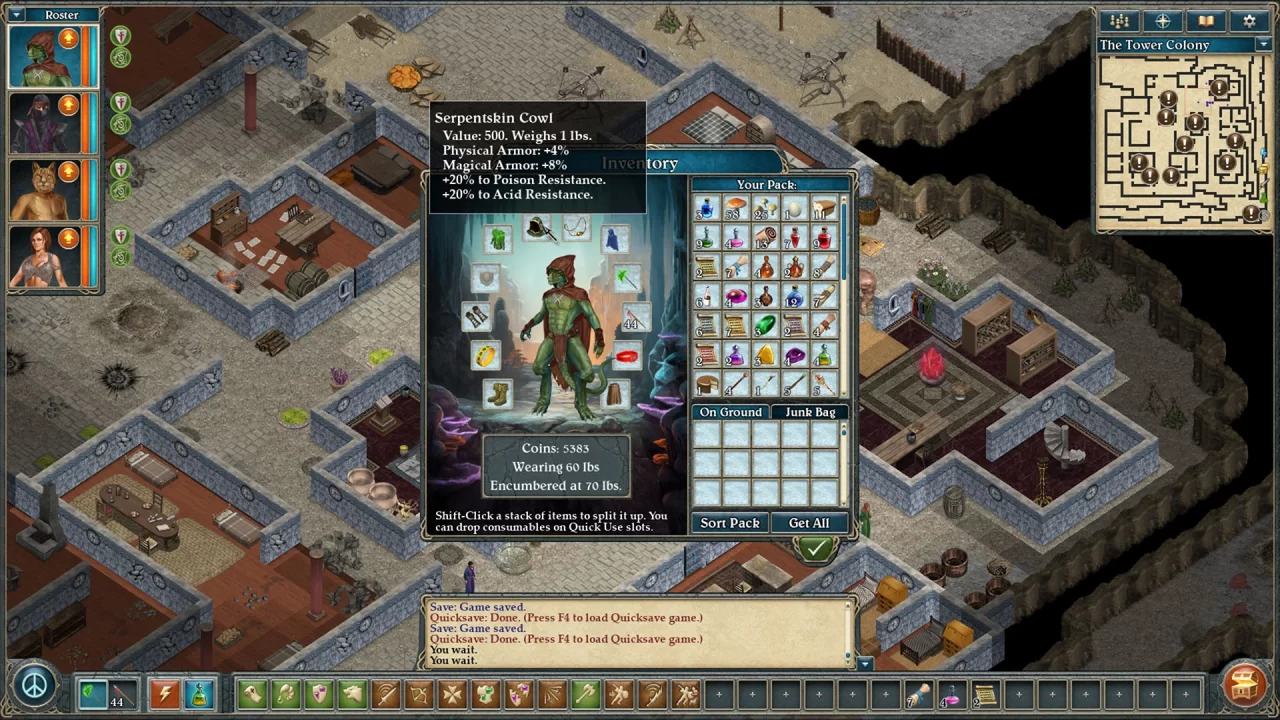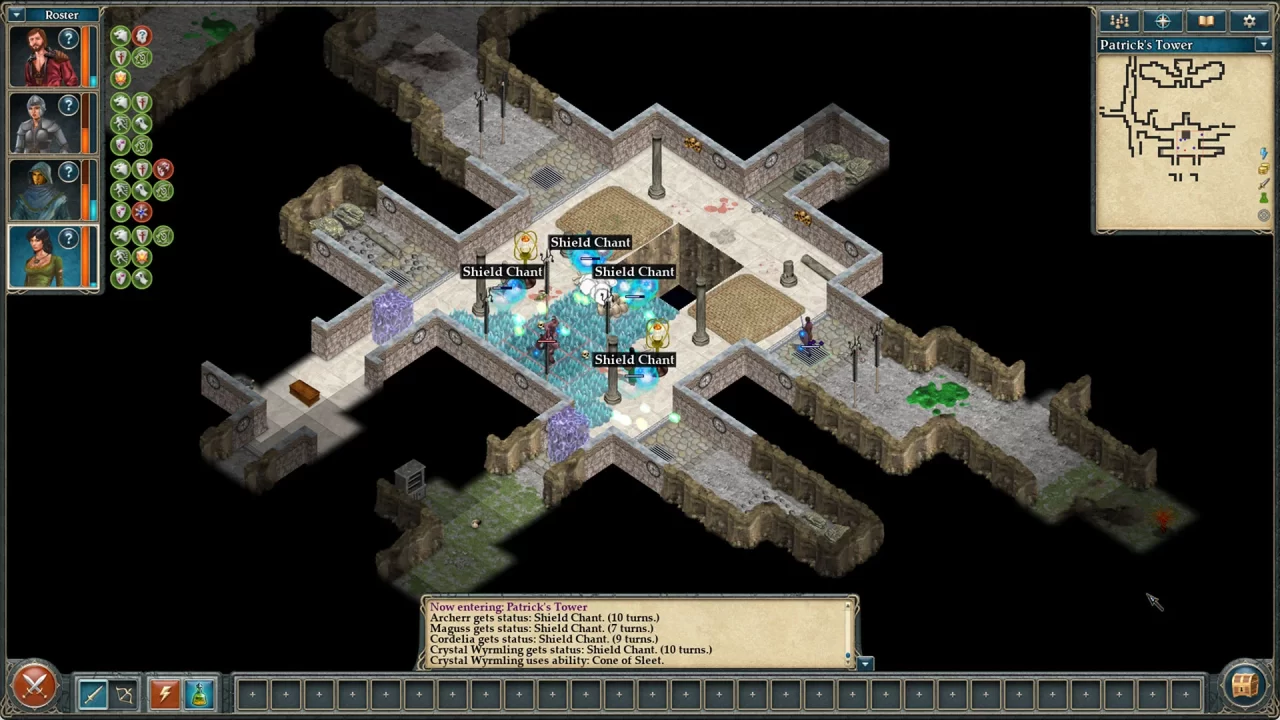The modern CRPG revival shows no sign of slowing down, and Spiderweb Software’s latest remaster keeps the momentum going. To mark the 25th anniversary of Avernum 4, founder and lead developer Jeff Vogel is revisiting the classic with an updated edition packed with new features and a refreshed interface built for modern systems. Unlike the Geneforge remaster from a year or so back, Avernum 4: Greed and Glory tells a more traditional, party-based fantasy tale. Yet it still thrives on the rich worldbuilding, vast exploration, and sharp writing that have defined Vogel’s work from the start. Avernum 4: Greed and Glory stands as another strong entry in the CRPG pantheon and a fine entry point for newcomers, though it will likely resonate most with those who fondly remember CRT monitors, late-night pizza runs, and the shrill whine of dial-up connections.
Avernum 4: Greed and Glory takes place almost entirely in a vast underground realm of caverns and hidden settlements. This sunless world was once a prison for the Empire’s criminals and exiles, but it has since grown into a thriving civilization of its own—the titular Avernum. Your party of four adventurers descends into this underworld in search of freedom, fortune, or whatever drives you onward. But Avernum is in turmoil. Powerful factions clash, bandits roam the tunnels, and ancient magics stir once more, leaving the government struggling to maintain order. Travel has become dangerous, and forbidden for most. For a group of hardy adventurers, though, such chaos is the perfect opportunity. Before long, you’ll find yourself at the center of uncovering what’s truly happening below.
The story feels carefully crafted, clearly developed over many years in the developer’s mind, and takes advantage of additional plot elements added in this remaster. Like Geneforge, it blends pastoral fantasy with technological influences and themes that echo the world we live in today. Avernum 4: Greed and Glory boldly examines the rights of a new civilization and questions whether past actions can truly be rewritten into new friendships. As you progress, you can choose sides among different factions and shape the story’s direction. The game’s structure stays open throughout, with few areas locked behind story progression. By the mid-game, the paths you take and the quests you pursue depend entirely on how far you want to explore.
The graphical assets and artwork closely resemble Spiderweb’s previous remasters, adding or changing little from those earlier efforts. There are, however, some striking flashes of detail—intricate crystal formations, humanoid-sized mushrooms, and sprawling city homes—that stand out. Still, this is a game that relies heavily on the player’s suspension of disbelief, or rather, the extension of their imagination. And, across many hours of adventure, it can be difficult to associate specific characters with a distinct image or voice. Similarly, spell and ability effects are understated, and high-level combat doesn’t always look or feel as powerful as it should.
The music and sound design are quite minimal, relying on simple movement noises and basic interaction effects. Audio cues are sparse, and while this fits the game’s atmosphere of deep isolation, Avernum 4: Greed and Glory is the kind of experience where an external playlist becomes essential—perhaps something more uplifting or soul-enriching to balance the mood.
If you’ve played any Spiderweb Software game since 1994, the character and combat systems will feel instantly familiar. The core mechanics stay consistent across different settings and series, remaining solid and reliable. Combat and exploration both rely on a progression system divided into physical and magical skills, with a few technical ones like Tool Use or Cave Lore mixed in. You assign stat points at character creation and each time you level up, shaping your character’s strengths as you choose. Your initial class and ancestry choices add another layer of strategy, since each combination grants its own weight. The catlike Nephils excel as archers thanks to their natural bonuses with missile weapons, while humans’ ability to wear any robe or armor lets them adapt to many roles. Every class remains flexible, though—you can train a fragile mage in Pole Weapons just as easily as in Spellcraft if you want to defy expectations.
At certain levels, you can choose Traits that enhance your core stats—boosting strength, increasing critical hits, or adding extra damage against physically vulnerable enemies. As you progress into the late game, these Traits grow more powerful and diverse, turning build planning into a strategic system of its own.
Combat works in a straightforward, turn-based system that switches to a grid layout once you engage an enemy or mob on the world map. There’s no visible turn order, but each combatant acts according to their initiative. Abilities cover the familiar range, from melee and magical attacks to defensive buffs and debuffs. Enemies often arrive in waves once they detect you, so the game rewards clever use of area-of-effect spells and smart positioning in narrow passages or chambers. During battles, the AI proves capable, keeping ranged attackers at a safe distance while sending tougher melee foes to pin down your party.
Enemy variety remains fairly limited, consisting mainly of humanoids, underground vermin, and undead monstrosities. The game adds depth through resistances: even creatures that look similar may resist melee attacks but remain vulnerable to Poison or Curse damage. You don’t need to figure this out through trial and error, either—right-clicking an enemy in combat displays their vital statistics instantly.
Avernum 4: Greed and Glory has a vast story, sidequests, and environments that can easily consume dozens of hours to fully explore. Beyond the many hidden areas and secrets, the game features a deep crafting and trade system to keep players engaged. It doesn’t include mini-games or alternative side activities; instead, the focus remains on exploration and uncovering the world’s stories. The game’s attention to detail and devotion to its lore create a consistent, lived-in universe. Every structure and point of interest—from abandoned farmhouses to almighty castle keeps—has a purpose. While there is a critical path and marked key locations, it encourages players to deviate, explore, and spend time in its nooks and crannies. Visiting shops and interacting with the articulate inhabitants is part of the experience. Players who aren’t inclined to engage this way may find the game feels like a slow slog through verbose, similar-looking settlements.
There are a few minor frustrations. While the UI is much smoother than the original, zooming the map isn’t intuitive, and you can’t right-click to exit menus or dialogue options—so be ready to rely heavily on the keyboard and mouse. There is no gamepad support. Other niggles are common across the remaster series: combat still suffers fiddly target selection, often leading to misclicked targets or accidental movements. On the bright side, the game offers a very generous save/load system. Seamless world transitions and a fast-travel feature—which becomes available relatively early—help mitigate some of the quirks typical of classic CRPG design.
Avernum 4: Greed and Glory is akin to reading a good fantasy novel: it’s deeply engrossing at times, requiring a fair bit of imagination to bring the world to life, and likely not the most modern method of accessing such content. But in saying this, the subterranean stories of Avernum, and its many detailed factions and quests keep you moving forward and invested in what’s coming over the next hill cavern. The commitment to playing an open role and of exploring everything on your own terms and time is an element many modern games still cannot offer in the same way. For those with such a bent, and with a willingness to engage their imagination and forgive some older design elements, Avernum 4: Greed and Glory will suck you deep into its yawning, cavernous depths.





